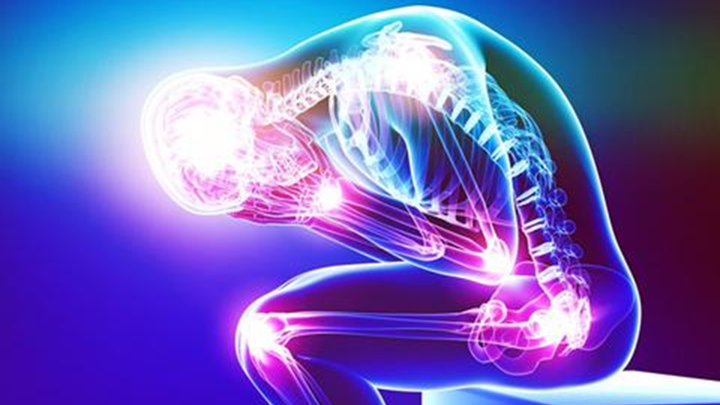 Chronic pain is a major public health concern that has immense societal and economic impacts. It is estimated that more than 50 million US adults currently suffer from some type of chronic pain and that approximately 10.6 million of those affected have activity limitations related to their pain. In 2010, a US report was released that estimated the total financial cost of pain to society to be $560 to $635 billion, which outranked heart disease, cancer, and diabetes combined.
Chronic pain is a major public health concern that has immense societal and economic impacts. It is estimated that more than 50 million US adults currently suffer from some type of chronic pain and that approximately 10.6 million of those affected have activity limitations related to their pain. In 2010, a US report was released that estimated the total financial cost of pain to society to be $560 to $635 billion, which outranked heart disease, cancer, and diabetes combined.
Chronic pain is often defined as pain persisting for three or more months. The most common pain locations are the lower back, joints, the neck, the head (migraines), and the legs, with joint and low back pain being the most prevalent.
Pain management providers have been working to improve care for those suffering with chronic pain as this entity can be difficult to treat. Typically, a combination of medications, invasive pain procedures, or ultimately surgery are employed to combat chronic pain.
With the emergence of the opioid crisis (the rapid increase in the use of prescription and non-prescription opioid drugs particularly in the United States), there is a greater need to identify alternative approaches to treat pain. Focused ultrasound has already shown promise to be one of those alternatives. It offers a noninvasive treatment approach to some of the most common painful conditions existing today.
The following is an overview of the types of pain that are currently being treated with – or investigated for treatment with – focused ultrasound therapy. They include several types of arthritis, bone pain, neuropathic pain, stump neuroma, and cancer pain.
Arthritis
Arthritis is inflammation of a joint, and although there are many different types, the two most common are osteoarthritis (degeneration with aging or repetitive use) and arthritis caused by autoimmune disease such as rheumatoid arthritis. The joints that are most commonly affected are the hands, feet, knees, hips, and back, and the main symptoms include pain and stiffness. Over time, these symptoms can significantly affect one’s quality of life and cause depression, difficulty in performing activities of daily living, and disability. Focused ultrasound can reduce pain caused by arthritis by destroying the sensory nerves along the surface of the affected joint.
Back pain secondary to facet arthritis and sacroiliac (SI) joint dysfunction
Up to 40 percent of chronic low back pain can be attributed to arthritis of the lumbar facet joints, which are the joints along either side of the spine that allow flexibility of the vertebral bodies. An additional 15 to 30 percent of low back pain can be attributed to arthritis of the sacroiliac (SI) joints, which are the joints that connect the back to the pelvis. Inflammation of the sensory nerves that travel along the facet and SI joints cause pain signals to be transmitted to the brain. Blocking these pain signals allows the patient to experience less or no pain.
The most common method for treating lumbar facet disease and SI joint pain is radiofrequency ablation (RFA), an invasive procedure where needles are inserted into the back to heat and destroy the sensory nerves that are causing pain. Preclinical laboratory studies and clinical research demonstrates the ability of focused ultrasound to safely and noninvasively destroy the same nerves surrounding affected lumbar facet and SI joints, thereby eliminating the risks of bleeding or infection that are associated with RFA treatment. Varying imaging guidance systems, such as MRI or x-ray fluoroscopy, can be used to localize the nerves, which reside in predictable locations near the painful joint.
Science highlight
Published in 2012, Weeks and colleagues at Imperial College Healthcare NHS Trust, London performed a clinical trial to evaluate the safety and efficacy of focused ultrasound to treat facet joint osteoarthritis pain. Thirteen patients received treatment and were enrolled to follow up. The average pre-treatment pain score was 6.4, and post-treatment this was reduced by an average of 3.87 (60.2 percent). In addition, a reduction in disability scores by 60 percent was reported. These statistics are comparable to those seen with conventional RFA techniques, which are the current recommended first line of therapy for facet joint pain. Thus, this suggests that focused ultrasound might provide a noninvasive yet just as effective therapy for facetogenic back pain as the traditional, invasive RFA technique. Read the publication >
Osteoarthritic knee pain
Knee osteoarthritis (OA) ranks among the most common disabling arthritic conditions in the elderly. It is estimated that approximately 10 percent of males and 18 percent of females have symptomatic knee OA. Conservative measures are typically used to control pain associated with knee OA before moving to total knee replacement. Such measures include physical therapy and non-steroidal anti-inflammatory drugs, then progressing to invasive procedures such as intraarticular injection of steroids. Unfortunately, these treatment options are often insufficient to control the pain associated with knee OA, especially if it is severe. Focused ultrasound has shown promise as an alternative or adjunct to treat knee OA pain by destruction of the sensory nerves along the inner lower surface of the knee joint.
Science Highlight
In a clinical study published by Izumi and colleagues in 2013, six out of eight (75 percent) patients reported significantly lower pain scores at three days, ten days, and one month after focused ultrasound treatment of knee pain. There were no side effects or complications during or after focused ultrasound therapy. Read the publication >
An additional clinical trial in Japan that is being funded by the Foundation is currently underway. This study aims to further evaluate the safety and efficacy of focused ultrasound for knee OA. At this time, the researchers report that they have completed the recruitment phase of the study, having 10 out of 10 participants treated. Results of the long-term analysis are forthcoming.
Osteoarthritic hand and hip pain
Given the success of focused ultrasound to treat OA of the knee and facet joints, researchers are currently in the early stages of planning to evaluate whether it is feasible to also treat hand and hip pain secondary to OA in a similar manner.
HEAR FROM AN EXPERT
 Motohiro Kawasaki, MD, PhD, Kochi Medical University Hospital in Japan
Motohiro Kawasaki, MD, PhD, Kochi Medical University Hospital in Japan
“High-intensity focused ultrasound treatment has been performed on the source of pain, with the indication that the patient is resistant to conservative treatment and has an identifiable source of chronic pain. Approximately 70 percent of patients showed over 50 percent improvement in their pain after the treatment. After one year of follow-up, chronic pain remained ameliorated in approximately 50 percent of patients, and analgesics were reduced. I believe HIFU is one of the innovative treatment options for patients who cannot have surgery or who are considering other treatments.
“Moreover, if a drug delivery system that has become a topic in recent years can be used to cause analgesia to reach the site of the source of pain, the effects on bone and cartilage around the treated site will be further reduced while showing less invasive and effective analgesia. Then, the role of HIFU in the treatment of chronic osteoarthritis pain can be estimated to become higher. I look forward to the further development of HIFU treatment for chronic pain associated with osteoarthritis.”
Bone Tumors
Bone metastases
Bone pain from cancer metastasis is a common clinical problem that is difficult to treat. Patients often experience significant pain and debilitation, decreasing quality of life. The primary palliative treatment for patients with painful bone metastasis is radiation therapy; however, more than 40 percent of patients’ pain is still not controlled after this therapy. Radiation is also associated with various side effects and is limited by cumulative dosing restrictions.
Focused ultrasound has emerged as an effective alternate treatment option for painful bone metastasis by means of ablating the nerves around the area in which metastasis has occurred. In 2011 and 2012, the European regulatory bodies and the FDA, respectively, approved focused ultrasound to treat pain from bone metastases. Focused ultrasound is not associated with the typical side effects from radiation and can be repeated as often as necessary. This indication is one of the very few that has insurance coverage within the US. It is currently recommended as second-line therapy after failure of radiation therapy, but there are certain patients who are ineligible or unwilling to receive radiation, in which case focused ultrasound can become the first-line treatment.
Science Highlight
In 2018, Bertrand and colleagues published a single-center, prospective study to evaluate the effectiveness and feasibility of focused ultrasound for the treatment of bone metastasis. Seventeen consecutive patients with symptomatic bone metastasis were treated with MR-guided focused ultrasound. The clinical course of the patients’ pain was evaluated at one week and one month after treatment, and the patients’ consumption of opiates was also recorded. Results showed that all patients experienced a decrease in pain at the stated time intervals, and 40 percent reported no pain at all after one month. The mean intake of opiates in morphine equivalents was 270.6 at baseline and decreased to an average of 113.75 at one month post procedure, although this difference was statistically insignificant. At the time of this publication, an international consensus statement recognized focused ultrasound as a safe and effective secondary treatment option in painful and radiation-refractory bone metastasis. This additional study confirms that focused ultrasound is a safe and effective treatment procedure for the pain caused by bony metastasis. Read the publication >
Osteoid osteoma
Osteoid osteoma (OO) is a small, painful, and benign bone lesion that accounts for 10 percent of all bone tumors. This disease most commonly affects young people, typically males between the ages of 10 and 35. OOs usually occur in the long bones (femur, tibia, and humerus), but can also be found in the pelvis and spine. Although usually small, the bony lesions associated with OO can be excruciatingly painful as the tumor secretes chemicals that cause pain. The standard treatment for OO is CT-guided RFA, an invasive procedure involving the insertion of needles around the tumor, which are then used to heat and destroy the tissue. However, focused ultrasound has been studied as an alternate, noninvasive therapy to treat symptomatic OOs. With this technique, the ultrasound beams are focused on the tumor nidus in order to ablate the tumor cells that secrete the pain-causing chemicals.
Multiple clinical trials using focused ultrasound report excellent success in reducing patient’s pain and disability, and these outcomes have been durable over time. Two different focused ultrasound devices have achieved regulatory approval in Europe for the treatment of OO. Additionally, an international registry that collects data for comparing OO treatments was created and is managed by The Hospital for Sick Children (SickKids) in Toronto, Canada. The registry tracks and assists with the enrollment of patients with OO who are participating in ongoing clinical trials.
Science Highlight
From 2010 to 2012, Geiger and colleagues performed a prospective, multicenter, cohort study to evaluate the technical success of the treatment of non-spinal, painful OOs with the use of focused ultrasound. Thirty patients from three different orthopedic centers who had painful OOs were recruited for treatment. A total of twenty-nine patients completed the treatment, as well as the 12-month follow-up evaluation. There were no reported complications. The mean pain score (on a 10-point scale) at baseline was eight, and at the one-month post-treatment follow-up, twenty-six out of twenty-nine patients had a pain score of zero; this remained unchanged until the final follow-up. The remaining three patients had partial response to treatment with a mean pain score of five that went unchanged during follow-up. This multicenter study demonstrated that focused ultrasound treatment for non-spinal OO is safe, noninvasive, and highly successful with a 90 percent clinical success rate. This success rate is equivalent to that of CT-guided RFA. Read the publication >
HEAR FROM AN EXPERT
 Alessandro Napoli, MD, PhD, Professor of Radiology, La Sapienza University of Rome
Alessandro Napoli, MD, PhD, Professor of Radiology, La Sapienza University of Rome
“Pain originating from bone tumors is extremely debilitating and challenging to cure. Bone pain is actually much more frequent than generally thought. Benign bone tumors can significantly impair quality of life and can affect both children and young adults alike. Focused ultrasound treatment has been demonstrated to be an extraordinarily powerful tool in treating bone pain. It is safe and effective and features a quick response that rapidly improves a patient’s quality of life. Given the fast response to focused ultrasound treatment and the zero-radiation emission factor, focused ultrasound should be considered a first-line therapy in patients with bone pain not responding to pharmacological treatment.”
Neuropathic Pain
Chronic neuropathic pain is a debilitating condition that is difficult to treat with conservative measures. In the United States, it is estimated that approximately 10 percent of the population suffer from this condition. Central and peripheral neuropathic pain involves dysfunction and disease of nerves within the brain, spinal cord, and appendages. This type of pain may be associated with abnormal sensations or pain from non-painful stimuli (allodynia). Common qualities of the pain are described as burning, pins and needles, numbness, and itching.
Central neuropathic pain is usually secondary to spinal cord injury, multiple sclerosis, or stroke and affects nerves within the central nervous system (the brain and spinal cord). Peripheral neuropathy can be caused by a multitude of diseases (diabetes, herpes zoster, HIV, immune related diseases) or by direct trauma/compression of nerves located outside of the brain and spinal cord, namely in the arms and legs.
Traditional methods for treating neuropathic pain include medication management with anticonvulsants, antidepressants, and gabapentin; invasive procedures such as peripheral nerve blocks with long-acting local anesthetics; and major surgeries, such as deep brain stimulation and spinal cord stimulators, where probes are placed in eloquent areas of the brain and spine. Central lateral thalamotomy (CLT) was initially developed using RFA to treat neuropathic pain. With this technique, a specific area within the brain called the thalamus is targeted with an electrical current by inserting a needle into the brain to heat and destroy the tissue. The technical and anatomical aspects of CLT have since been adopted for use with noninvasive focused ultrasound. During this technique, ultrasound beams are focused on the very specific, small target in the brain where pain is processed called the thalamus. The tissue in this area is heated and destroyed by the ultrasound beams with the goal of decreasing or completely eliminating the chronic pain signals originating from this area.
Science Highlight
In 2012, Jeanmonod and colleagues published a study of nine patients with chronic neuropathic pain who underwent successful CLT using focused ultrasound. The subjects’ pain scores were reduced by an average of 42 percent at three months post-procedure, and 40 percent after one year. In addition, five of the patients reported at their one-year follow up that they had stopped taking any medications for pain. Read the publication >
The University of Maryland is currently conducting a similar study, which is being funded by the Foundation. Researchers there are targeting the thalamus with focused ultrasound to treat chronic neuropathic pain. To date, five patients have been treated. There was a recent story published in the Baltimore Sun about this study and the early findings.
The University of Virginia is also conducting a study using focused ultrasound to treat craniofacial neuropathic pain. This particular type of pain occurs only in the head and face. The investigators are again targeting the same area in the brain as the above studies (the thalamus). Two patients have been treated to date.
HEAR FROM AN EXPERT
 Dheeraj Gandhi, MD, Professor of Radiology, Neurology, and Neurosurgery, Director of Interventional Neuroradiology, Clinical Director of the Center for Metabolic Imaging and Therapeutics (CMIT), University of Maryland
Dheeraj Gandhi, MD, Professor of Radiology, Neurology, and Neurosurgery, Director of Interventional Neuroradiology, Clinical Director of the Center for Metabolic Imaging and Therapeutics (CMIT), University of Maryland
“Neuropathic pain is a disabling and chronic condition with few effective therapies. The drugs used to treat this condition often result in a partial response to therapy and result in serious adverse effects and addiction potential. MR-guided focused ultrasound therapy could provide an attractive option for these patients.
“At University of Maryland, a feasibility and safety trial is currently underway. In its first phase, five patients have been treated successfully and safely. Early results appear promising. If durable results are obtained, the investigators hope to initiate a sham-controlled, multicenter, randomized trial.” Read an investigator profile on Dr. Gandhi >
Stump Neuroma
After amputation or partial amputation of a limb, the nerves that were severed are at risk for developing a neuroma, which is a benign, abnormal growth of nerve tissue. Neuromas can be exquisitely tender and are also thought to be the cause of phantom limb/residual limb pain. These painful bundles of nerve tissue are often difficult to treat and usually require surgical excision or re-implantation. A noninvasive treatment approach to alleviate the pain associated with this condition is not yet available, but focused ultrasound could provide that option, and studies are underway to assess its potential.
Science Highlight
A clinical trial funded by the Foundation at Rambam Medical Center in Haifa, Israel, is evaluating the efficacy of focused ultrasound to treat the pain associated with amputation stump neuromas. Interestingly, early results indicate that there may be multiple possible mechanisms in which focused ultrasound could alleviate the pain associated with these neuromas: thermal ablation and neuromodulation (inhibition and/or stimulation of nerve tissue) are both under consideration.
Cancer Pain
In addition to treating pain caused by bone metastasis, work is being done with focused ultrasound to treat pain caused by other cancers, such as pancreatic cancer. Focused ultrasound is effective in the treatment of cancer pain by direct reduction of tumor size and destruction of sensory nerves surrounding the tumor, both via thermal destruction.
Science Highlight
In 2016, Strunk and colleagues treated 15 patients with painful, inoperable pancreatic cancer with focused ultrasound. In addition to significant volume reduction of the tumor itself, considerable pain relief was achieved in 12 patients, with 6 of them experiencing complete pain relief. Read the publication >
Several other published clinical trials evaluating focused ultrasound for cancer pain have shown similar results to the above study, and there are more clinical trials currently underway. Additional information regarding this work can be found on the Foundation’s Cancer Pain page.
HEAR FROM AN EXPERT
 Joan Vidal-Jove, MD, PhD, Head of Surgical Oncology at Barcelona University Hospital, Barcelona, Spain
Joan Vidal-Jove, MD, PhD, Head of Surgical Oncology at Barcelona University Hospital, Barcelona, Spain
“Focused ultrasound safely controls in a noninvasive manner the neuropathic pain from pancreatic cancer in a noninvasive manner, once and for all. We have been pleased to find that patients with oncologic pain from primary or metastatic tumors can rely on focused ultrasound as a new hope for its definitive control.” Read an investigator profile on Dr. Vidal-Jove >
Conclusion
As described above, focused ultrasound has the potential to provide a noninvasive and safe treatment option for patients with chronic pain. The benefits of noninvasive focused ultrasound compared to other treatment strategies include the elimination of bleeding and infection, which is especially problematic in the elderly population. The use of anticoagulation is not a contraindication, nor does it need to be temporarily stopped for the procedure. In addition, there is potential for decreased cost with lack of sterilization equipment, less radiation to the patient and the treating physician, and reduction in the consumption of addictive medications such as opioids. Focused ultrasound is already being employed clinically to treat painful bone metastases, lumbar facet joint arthritis, and osteoid osteoma. It holds much promise for other painful conditions.
